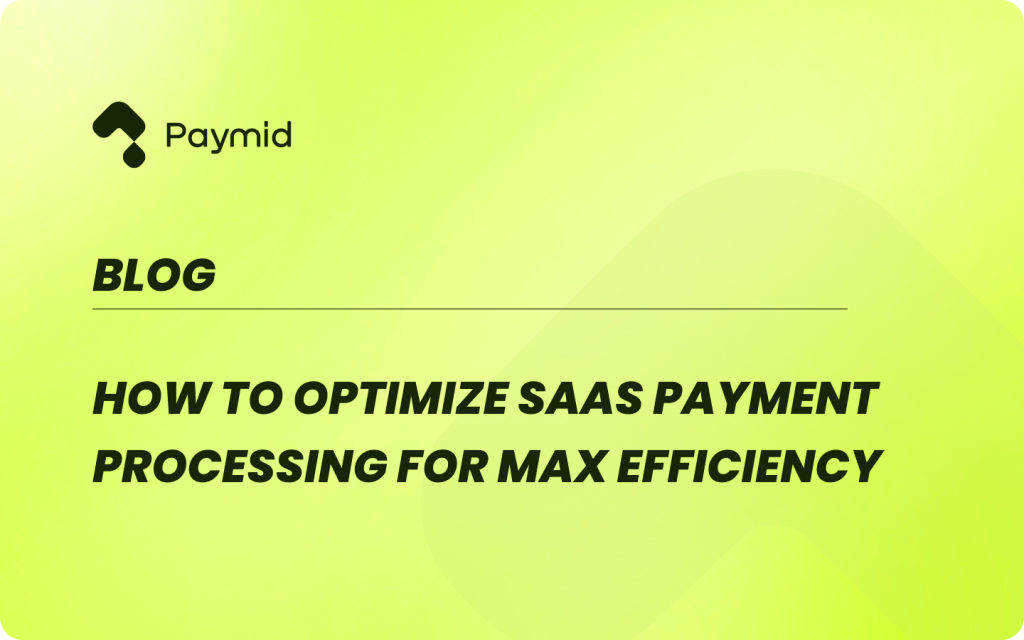How To Optimize SaaS Payment Processing For Maximum Efficiency

Payment processing efficiency directly impacts the success of SaaS businesses, affecting everything from customer satisfaction to revenue optimization. Modern SaaS payment processing systems must handle complex subscription models, varying payment methods, and international transactions while maintaining strict security standards and regulatory compliance.
The right SaaS payment solutions can transform how businesses manage their financial operations. Companies need robust payment gateways for SaaS applications that integrate seamlessly with their existing infrastructure.
- Effective payment systems in SaaS hinge on a robust architecture, integrating key components like gateways, subscription management, and security to manage complex subscription models, international transactions, and regulatory compliance.
- Automated workflows and comprehensive monitoring improve payment accuracy, reduce manual intervention, and enable real-time tracking, supporting consistent revenue streams and streamlined operations.
- Strategic scaling techniques—such as load balancing, database optimization, and microservices architecture—allow SaaS payment systems to handle increasing transaction volumes while maintaining efficient performance and reliability.
Understanding SaaS Payment Architecture
The foundation of efficient SaaS payment processing lies in its architectural framework, which combines multiple components to create a seamless payment experience. A well-designed SaaS payment architecture enables businesses to manage subscriptions, process transactions, and ensure security while maintaining scalability[1].
Core Components of Payment Systems
The essential building blocks of a SaaS payment system include:
- Payment Gateway Integration.
- Subscription Management System.
- Merchant Account Services.
- Revenue Analytics Platform.
- Transaction Processing Engine.
These components work in concert to facilitate recurring billing, handle variable pricing plans, and manage customer accounts effectively[2].
Integration Points and Dependencies
Modern SaaS payment solutions require seamless integration with multiple systems and services. The payment architecture must interface with user authentication systems, subscription management tools, and external payment processors[3]. Integration points typically include APIs for payment processing, webhook endpoints for transaction notifications, and database connections for storing customer information.
Security Requirements and Compliance
Security forms the cornerstone of SaaS payment architecture. Organizations must implement robust security measures to protect sensitive payment data and maintain compliance with industry standards.
PCI DSS compliance for handling credit card data, tokenization of payment information, and implementation of fraud detection systems[4]. The architecture must support risk-based authentication and regular compliance audits to ensure ongoing security.
The system should incorporate machine learning algorithms for fraud detection and maintain comprehensive audit trails for all payment activities. Additionally, the architecture must facilitate automatic sales tax calculations and support international payment regulations, making it crucial for businesses expanding into global markets.
Implementing Payment Automation
Automating payment processes has become crucial for modern SaaS businesses seeking to streamline their financial operations. A well-implemented payment automation system can significantly reduce manual intervention while improving accuracy and efficiency[5].
Workflow Automation Strategies
Organizations implementing SaaS payment automation should focus on creating seamless workflows that integrate with existing systems. The key benefits of automated payment workflows include:
- Reduced manual data entry and processing.
- Streamlined financial operations.
- Enhanced day-to-day workflow efficiency.
- Improved accuracy in payment processing.
- Real-time tracking and reporting capabilities.
Smart dunning strategies and pre-dunning processes help prevent failed payments before they occur. Implementing alternative payment methods and account updater services can significantly improve payment success rates.
Error Handling and Recovery
Effective error handling is essential for maintaining robust payment processing systems. Organizations should implement structured logging and monitoring systems to catch and resolve issues quickly[6]. The implementation should include:
Real-time error monitoring with defined alert thresholds, multiple notification channels for critical issues, and automated retry mechanisms with exponential backoff strategies. Circuit breakers and dead letter queues help manage system failures gracefully while maintaining system stability.
Testing and Validation Procedures
A comprehensive testing strategy ensures payment systems operate reliably and securely. Testing should follow the GAMP5 validation approach, which includes installation qualification, operational qualification, and performance qualification testing[7].
Organizations must validate their payment systems across multiple dimensions, including functional testing, security validation, and performance testing. Stress testing under various load conditions helps identify potential bottlenecks and system limitations before they impact production environments.
Integration testing should verify the compliance of all system components with specific functional requirements, while performance testing evaluates the system’s speed and responsiveness under different transaction volumes[8].
Optimizing Payment Operations
Effective monitoring and optimization of payment operations are crucial for maintaining a robust SaaS payment processing system. Organizations must implement comprehensive monitoring strategies to ensure optimal performance and reliability of their payment infrastructure.
Performance Monitoring Tools
Modern SaaS payment solutions require sophisticated monitoring tools to track critical metrics and ensure smooth operations. Essential monitoring components include:
- Transaction Success Rate Tracking.
- Payment Gateway Response Times.
- Authorization Rate Monitoring.
- Chargeback Rate Analysis.
- Revenue Leakage Detection.
Real-time analytics dashboards enable organizations to identify potential issues before they impact business operations. These tools provide valuable insights into payment trends, helping businesses optimize their payment processing strategies and reduce operational inefficiencies[9].
System Health Checks
Regular system health assessments are vital for maintaining optimal payment processing performance. Organizations should implement automated health checks that monitor various aspects of the payment system, including gateway connectivity, network latency, and service availability.
Smart dunning management systems help prevent revenue leakage by automatically handling failed payments and retry attempts. These systems incorporate intelligent retry logic based on specific gateway transaction errors, improving recovery rates and maintaining consistent revenue streams.
Resource Utilization Management
Efficient resource management is essential for scaling SaaS payment processing operations. Organizations must implement usage-based monitoring systems to track resource consumption and optimize system performance. This includes monitoring database performance, API usage patterns, and system throughput[10].
Proactive capacity planning helps organizations anticipate and address potential bottlenecks before they impact payment processing capabilities. By analyzing historical usage patterns and growth trends, businesses can make informed decisions about resource allocation and infrastructure scaling.
Implementation of smart routing features enables automatic gateway selection based on payment methods and transaction currencies, optimizing resource utilization across different payment processors. This approach ensures efficient processing while maintaining high availability and transaction success rates[11].
Scaling Payment Infrastructure
Scaling a SaaS payment infrastructure requires a strategic approach that combines robust architecture with efficient resource management. As businesses grow, their payment systems must evolve to handle increased transaction volumes while maintaining performance and reliability.
Load Balancing Strategies
Cloud-based load-balancing solutions offer significant advantages for SaaS payment processing. These systems distribute workloads effectively across multiple servers, ensuring consistent performance during peak periods[12]. Key benefits include:
- Automatic scaling during traffic spikes.
- Reduced latency through geographic distribution.
- Enhanced system reliability and uptime.
- Cost-effective resource utilization.
- Simplified disaster recovery.
Regional load balancers work alongside global server load balancing (GSLB) to optimize performance across different geographical locations, ensuring efficient payment processing regardless of customer location.
Database Optimization
Effective database optimization is crucial for maintaining high-performance payment processing as transaction volumes grow. Query optimization and proper indexing strategies play vital roles in ensuring quick response times and efficient data retrieval.
Organizations should implement regular performance monitoring and tuning procedures to maintain optimal database efficiency[13]. This includes analyzing query execution plans, optimizing index structures, and implementing efficient partitioning strategies to manage large-scale data effectively.
Microservices Implementation
Microservices architecture provides unprecedented flexibility and scalability for SaaS payment systems. By breaking down complex payment processes into smaller, independent services, organizations can achieve greater system resilience and easier maintenance.
Key microservices advantages include isolated failure points, independent scaling capabilities, and simplified updates. This architectural approach allows teams to work concurrently on different services, enabling faster feature deployment and more efficient resource utilization.
The implementation of microservices requires careful consideration of service boundaries and communication patterns. Organizations should focus on creating loosely coupled but highly cohesive modules that can operate independently while maintaining system integrity[14]. This approach enables businesses to scale specific components of their payment infrastructure based on demand, rather than scaling the entire system unnecessarily.
Read More:
- Mastering B2B Payment Optimization [Expert Tips]
- Merchant Acquirer vs Payment Processor: A Detailed Comparison
- The Ultimate Guide to Travel Payment Solutions for 2024
- Easy Ways to Accept Payments Online Without a Merchant Account
Are You Ready to Optimize Your SaaS Payment System?
Modern SaaS businesses must master payment processing efficiency to maintain a competitive advantage and ensure sustainable growth. This comprehensive exploration of SaaS payment optimization highlights several critical aspects for success.
Payment architecture serves as the foundation, combining essential components like gateways, subscription management systems, and security measures. Organizations that implement robust automation workflows, error-handling mechanisms, and thorough testing procedures position themselves for operational excellence.
Continuous monitoring through sophisticated tools and regular system health checks enables businesses to maintain peak performance. Smart resource management and proactive capacity planning help organizations adapt to changing demands while maintaining processing efficiency.
The scalability strategies discussed – from load balancing to database optimization and microservices implementation – provide organizations with clear pathways for growth. These approaches ensure payment systems remain reliable and efficient as transaction volumes increase.
Organizations that follow these optimization strategies position themselves to handle complex payment scenarios effectively while maintaining security and performance. Through careful attention to architecture, automation, operations, and scaling, businesses can build payment processing systems that support their growth objectives and enhance customer satisfaction.

